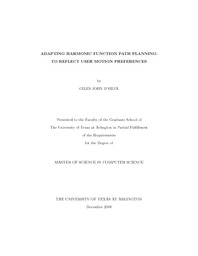| dc.contributor.author | D'Silva, Giles John | en_US |
| dc.date.accessioned | 2009-09-16T18:20:02Z | |
| dc.date.available | 2009-09-16T18:20:02Z | |
| dc.date.issued | 2009-09-16T18:20:02Z | |
| dc.date.submitted | January 2008 | en_US |
| dc.identifier.other | DISS-10066 | en_US |
| dc.identifier.uri | http://hdl.handle.net/10106/1813 | |
| dc.description.abstract | Every human in the real world has a unique motion preference while moving to achieve a given task. These preferences could be expressed by moving in a straight line, following the wall along a corridor, avoiding sharp turns, preferring hard flat surfaces over damp uneven surfaces, choosing the shortest path to the goal or by giving a high priority towards safety by maintaining a definite distance from obstacles. To automatically incorporate user preferences into motion planning we could extract the trajectories taken by the user to achieve a task in a given local vironment and attempt to use them in potentially similar environments. However these trajectories can not be easily generalized and the intermediate paths can generally not be inferred by interpolation between similar paths since the resulting path may not always lead to the goal or could sometimes even collide with an obstacle. As a result a motion planner using sample trajectories and path interpolation would lose the characteristic of a good path planner and may also fail to correctly represent the user's motion preferences while transferring such trajectories into more dissimilar environments. Motivated by this, the goal of this research is to design a path planner that is able to transfer user motion preferences in a parametric form to new similar local environments and to generate paths that are smooth, complete and correct. In this research we modify a harmonic function path planner to model the preferences of a user's motion as parameters which could then be used to generate new paths based on these preferences for potentially similar environment configurations. To model such preferences the representing parameters have to be learned using a machine learning algorithm. The algorithm extracts the trajectory data for the user whose preference we are trying to capture and computes the desired path (the harmonic function gradient) direction from every trajectory point. Next, it initializes the parameters to default values that generate a generic path to the goal. We then modify and update these parameters until a path is generated that matches the desired direction followed by the user. These parameters now represent the user's motion preference in that local environment and can be transferred into new, similar environments. We then input these parameters into our path planner to generate a path for this new environment. Since the path is generated by a harmonic function path planner it is complete and has no local minima or maxima and the user is assured of reaching the goal if a path exists. This customization of the path planner to learn user motion preferences could have potential applications in autonomous vehicles, semi autonomous wheel chairs, remote control of robotic systems or the creation of custom game characters. | en_US |
| dc.description.sponsorship | Huber, Manfred | en_US |
| dc.language.iso | EN | en_US |
| dc.publisher | Computer Science & Engineering | en_US |
| dc.title | Adapting Harmonic Function Path Planning: To Reflect User Motion Preferences | en_US |
| dc.type | M.Engr. | en_US |
| dc.contributor.committeeChair | Huber, Manfred | en_US |
| dc.degree.department | Computer Science & Engineering | en_US |
| dc.degree.discipline | Computer Science & Engineering | en_US |
| dc.degree.grantor | University of Texas at Arlington | en_US |
| dc.degree.level | masters | en_US |
| dc.degree.name | M.Engr. | en_US |
| dc.identifier.externalLink | http://www.uta.edu/ra/real/editprofile.php?onlyview=1&pid=190 | |
| dc.identifier.externalLinkDescription | Link to Research Profiles | |

